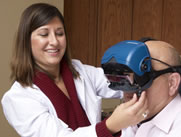Sinusitis
Sinusitis is a very common disease entity, which affects millions of patients per year. Sinusitis can be classified either into acute, subacute, or chronic sinusitis.
Acute sinusitis occurs when the sinus ostia become obstructed. This can be from blood, trauma, irritations, allergies, or manifestations of the sinusitis itself. After the inciting phase, the obstructive phase occurs. Blockage of the sinus openings leads to the pain and pressure associated with a relative vacuum or pressure inside the sinuses. This leads to an internal increase in the drainage, and the decreasing of the oxygen content within the sinus. All of these are very favorable for bacterial colonization. Once bacteria colonize a sinus, this can lead to the infective phase. Now, increasing production occurs due to the bacterial infection. This causes pain and pressure of the forehead, teeth, gums, and even back and top of the head. At this point, sinusitis usually manifests with an elevated temperature as well. Under severe circumstances, this infection may migrate to the eyes and the brain causing vision and life-threatening complications. Reversal this, the third stage, or the infective phase, revolves around the use of topical decongestants, anti-inflammatories including steroids and antibiotics. Once the acute phase resolves, the sinus ostia open, they are allowed to drain, the purulent infectious material is released, and air can now enter the sinuses, equalizing the pressure.
Should this occur greater than 6 weeks, this is known as subacute and manifestations of this disease that never completely resolve are called chronic sinusitis.
Chronic sinusitis may manifest merely as headache and face ache when the weather changes outside. Trapped air is either causing a relative pain, pressure, or vacuum associated with the rise and fall of the atmospheric pressure. There can also be an increased amount of drainage, congestion, fatigue, and malaise. Chronic sinusitis by definition is not reversible by medical treatment.
Surgical intervention includes a continuum of procedures some as mild as office sinuplasty using a balloon to dilate the sinuses. This can be done under a topical anesthetic with light oral sedation if requested in a similar fashion to filling a cavity.
More severe chronic sinusitis may require the use of an anesthetic and a brief outpatient surgical stay. A variety of tools including debriders or lasers are used and, unlike the past, no bruising or swelling or packing is required.
Should you have any further questions about acute, subacute, or chronic sinusitis, feel free to contact us.
|





